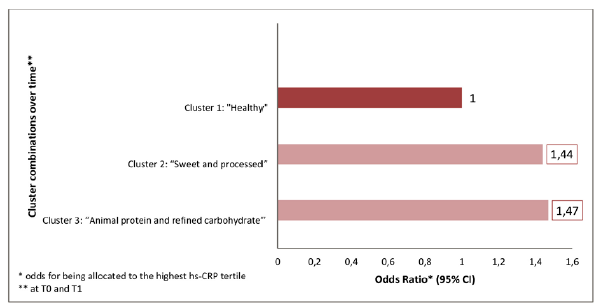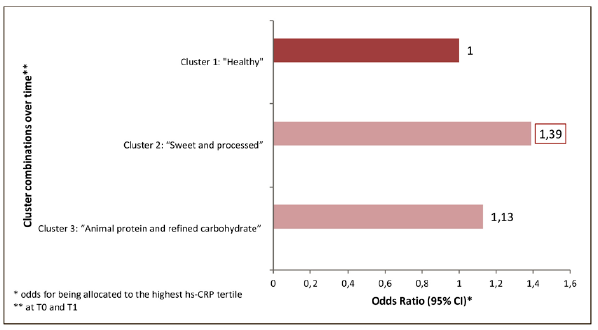The IDEFICS Study: prospective associations between dietary patterns and an inflammation marker in European children
High sensitivity C-reactive protein (hs-CRP) is the inflammatory marker most measured in epidemiological studies. It has been established that the hs-CRP is an emerging risk factor of cardiovascular diseases, even in children1,2. Numerous studies have shown that an unhealthy dietary patterns- characterized by high consumption of sugar or sugar products, processed foods, red meat and low F&V intake – is positively associated with the inflammatory status. Whereas, a dietary pattern rich in F&V is negatively associated with this status3,4. However, there are insufficient studies that link dietary patterns and chronic diseases in young populations.
The major aim of this multicenter study- the IDEFICS* study- is to describe the prospective relation between dietary patterns at baseline (T0) and at follow-up 2 years later (T1) and hs-CRP levels in European children aged between 2 and 9 years old (n=4020).
The three clusters of dietary patterns identified
Three consistent dietary patterns – defined by clusters- were found at T0 and T1, derived from the food frequency questionnaire (FFQ) that was administered to parents in order to evaluate the frequency of consumption of specific food items during the previous 4 weeks:
- Cluster 1: “healthy”– characterized by high frequency of F&V and whole grains food, and low consumption of sweet products;
- Cluster 2: “sweet and processed” – characterized by high frequency of sweet products and drinks, and low frequency of F&V;
- Cluster 3: “animal protein and refined carbohydrate”- characterized by high frequency of protein foods, water and some carbohydrate foods.
At both times, the dietary patterns were consistently similar in the two measurement points therefore it was possible to determine the relation between persistency/changes of dietary patterns over time in children and hs-CRP level.
A higher percentage of obese children were included in the “animal protein and refined carbohydrate” and “sweet and processed” clusters compared to the “healthy” cluster.
When analyzing the cluster memberships of children at baseline and follow-up, “animal protein and refined carbohydrate” cluster was the most stable because 76% of the children still follow this dietary pattern at T1, while 73.8% remained in the “sweet and processed” cluster over time and 71.2% persist in the “healthy” cluster until T1.
Associations between hs-CRP levels and dietary patterns
In addition, the associations between the hs-CRP and cluster membership at baseline (T0) and follow-up (T1) in children was assessed. For this purpose, subjects were categorized in two groups according to hs- CRP, i.e. the first and second sex-specific tertiles vs. the third sex-specific tertile.
Results of this study showed that there is a positive association between the “sweet and processed” and “animal protein and refined carbohydrate” patterns and inflammation over time. Children allocated in baseline and after two years to “sweet and processed” patterns had 44% higher probability of being in the highest hs-CRP category compared with those allocated to “healthy” cluster at baseline and follow-up while those allocated to “animal protein and refined carbohydrate” patterns over time had 47% higher probability of being in the highest hs-CRP category compared with those allocated to “healthy” cluster in both measurement times (Figure 1).

Figure 1: Multilevel logistic regression between dietary patterns over time and hs-CRP
When all the co-variables (Figure 2) were included, children allocated over time to “sweet and processed” pattern still had significantly higher probability (39%) of being in the highest hs-CRP category than those allocated to the “healthy” cluster in both measurement points.
Figure 2: Multilevel logistic regression between dietary patterns over time and hs-CRP when co-variables were included (age, parental education and BMI at T1, hs-CRP at T0 and sex, study region and medication)
A low F&V consumption in childhood is related with inflammation
These findings support the fact that a pattern characterized by a highfrequency intake of sugar, sugar products and processed products along with a low-frequency intake of F&V maintained over time is related to an inflammatory status in children. Thus, efforts to implement interventions and programs aimed at the increase of F&V consumption and the reduced consumption of sugar and processed products could prevent future disease risk related to inflammation.
* Identification and prevention of dietary-and lifestyle-induced health effects in children and infants
Based on: EM. Gonzalez‑Gil, G. Tognon, L. Lissner, T. Intemann, V. Pala, C. Galli, M. Wolters, A. Siani, T. Veidebaum, N. Michels, D. Molnar, J. Kaprio, Y. Kourides, A. Fraterman, L. Iacoviello, C. Picó, J.M. Fernandez‑Alvira, L.A.M. Aznar on behalf of the IDEFICS Consortium. Prospective associations between dietary patterns and high sensitivity C-reactive protein in European children: the IDEFICS study. Eur J Nutr 2017.
References
- Ford ES (2003). Circulation 108(9):1053–1058.
- Dowd JB, Zajacova A, Aiello AE (2010). Am J Prev Med 39(4):314–320.
- Lee Y, Kang D, Lee SA (2014). Nutr Metab Cardiovasc Dis 24(9):1004–1011.
- Defago MD, Elorriaga N, Irazola VE, Rubinstein AL (2014). J Clin Hypertens (Greenwich) 16(12):907–913
